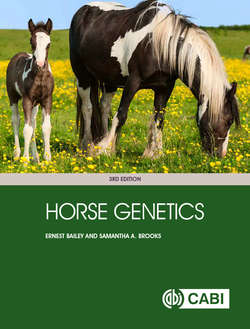Читать книгу Horse Genetics - Ernest Bailey - Страница 35
На сайте Литреса книга снята с продажи.
Zebras
ОглавлениеThe best-known feature of the African zebras is probably their extensive, distinctive striped coat patterns. Despite this common characteristic, the zebra group is genetically quite diverse. As can be seen from Table 3.1, they are typically regarded as belonging to three species groups (E. grevyi, E. quagga and E. zebra), and have chromosome numbers ranging from 32 to 46.
Grevy’s zebra (E. grevyi; Fig. 3.7) is characterized as a single species. The species is not very numerous and is classified as endangered. Several subspecies have been described for E. quagga (Fig. 3.8). E. q. burchellii has the common name of Burchell’s zebra, common zebra or plains zebra. Other subspecies of E. quagga have been recognized as E. q. boehmi (Grant’s zebra), E. q. zambiensis, E. q. borensis (maneless zebra), E. q. chapmani (Chapman’s zebra), E. q. crawshayi (Crawshay’s zebra), and E. q. selousi (Selousi’s zebra). This group is denoted as of “least concern,” meaning that the populations appear to be stable.
Fig. 3.7. Grevy’s zebra (E.grevyi) (picture provided by Zoological Society of San Diego).
Fig. 3.8. Buchell’s zebra (E. quagga) (picture provided by Zoological Society of San Diego).
E. zebra (Fig. 3.9) is considered to be vulnerable and occurs in two populations: the Hartman’s mountain zebra (E. z. hartmannae) and the Cape Mountain zebra (E. z. zebra).
Fig. 3.9. Hartmann’s zebra (E. zebra hartmannae) (picture provided by Zoological Society of San Diego).
Zebra species occupy distinctive ranges with limited overlap, especially in modern time. Chromosome painting has been used to identify the differences in genome organization among the different species (Trifonov et al., 2008). For more information, see Hack and Lorenzen (2008), Moehlman et al. (2008a), and Novellie (2008).
